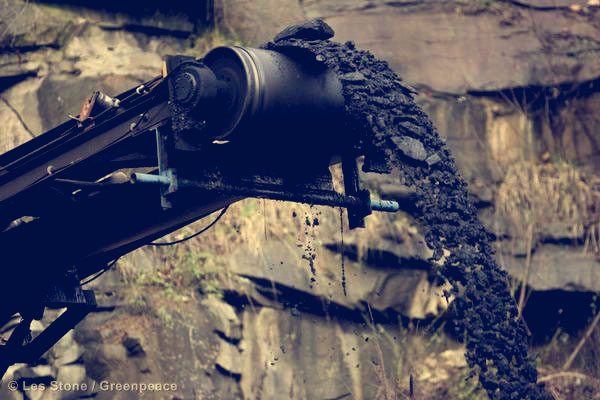In 2014, Greenpeace released Leasing Coal, Fueling Climate Change, which calculated the social cost of carbon for all federal coal leased under the Obama Administration and touched on some of the ways in which the federal coal program amounts to a major fossil fuel subsidy.
This report and Greenpeace’s work on the issue is intended to bring attention to the massive amounts of coal being unlocked through the federal leasing program. Climate change is an urgent issue, and it’s important to look forward and focus on what these leasing decisions mean for our energy future, both in the U.S. and globally. A recent Politifact article has raised some concerns about a rough comparison Greenpeace made between the potential carbon emissions from a proposed Bureau of Land Management (BLM) Regional Management Plan (RMP) and the cumulative avoided carbon emissions reductions between 2020 and 2030 in the (then) draft Clean Power Plan.
Here’s how we described this RMP in our 2014 report:
For example, the Buffalo Field Office of the Wyoming State BLM office has proposed a Regional Management Plan (RMP) and Environmental Impact Statement (EIS) which estimates 28 new coal leases amounting to 10.2 billion tons of coal. The Buffalo RMP proposal doesn’t include sufficient detail to calculate the quantity of carbon pollution as precisely as this report did for coal already leased during the Obama administration, but it is possible to estimate the carbon pollution using the same methodology that BLM has used for similar Wyoming coal. For its environmental review of the Hay Creek II coal lease in Wyoming, BLM estimated CO2 emissions from the coal using an “emission factor of 1.659 metric tons CO2/ton of coal burned” and we can assume similar sub-bituminous coal with relatively low BTU values in the Buffalo RMP area. That would mean this BLM field office expects to lease coal that would unlock an estimated 16.9 billion metric tons of carbon pollution. In comparison, the Obama administration’s Clean Power Plan is expected to reduce carbon pollution by 5.3 billion metric tons between 2020 and 2030, according to the Natural Resources Defense Council.
In May, President Obama’s BLM approved the Buffalo RMP. By carrying forward previous RMP decisions, BLM made a decision to keep open lands to leasing that could include 10.2 billion tons of publicly owned coal. As stated in the RMP and final EIS, “The BLM has estimated that it would issue 28 coal leases encompassing 106,400 acres with approximately 10.2 billion tons of coal and encompassing 106,400 acres in the two high-potential areas over the next 20 years.”
It is unlikely that all 10.2 billion tons of that coal would be burned by 2030, and that’s not what we’re saying. Acutely focusing on that timeline obscures the larger point — Regional Management Plans and leasing decisions made today will make available huge quantities of coal that will result in massive carbon pollution when burned over time. It is critical that we focus on these coal leasing and extracting decisions — especially when they’re buried in 3,000 page reports — before they’re finalized, because scientists have made clear that the vast majority of fossil fuels, including more than 90 percent of U.S. coal reserves, must remain in the ground.
The administration had an opportunity to re-evaluate this Regional Management Plan this year, see that it was out of sync with both the President’s call for urgent action on climate change and evolving energy markets, and chart a new course. Interior Secretary Sally Jewell herself has welcomed an “honest and open” conversation about reforming the federal coal leasing program, asking, “How do we manage the program in a way that is consistent with our climate change objectives?”
At minimum, BLM could have evaluated closing some lands for leasing or evaluated alternatives where a lesser amount of coal would be leased. Several environmental organizations wrote to the agency to encourage such steps. Instead, President Obama’s BLM determined that it was okay to keep those 10.2 billion tons of coal in the leasing pipeline in the midst of a climate crisis.
It’s encouraging to see BLM officials state on the record that they don’t believe most of this coal will be leased, especially since BLM has used almost absurdly bullish predictions for future coal consumption to justify coal leasing in the past. In the Record of Decision for last year’s Maysdorf II lease sale, BLM cited two studies to justify the long term demand for coal from the proposed lease; one projected coal will be 52 to 58 percent of domestic electricity generation by 2030 — a future so implausible it’s more humorous than terrifying. And this June, BLM accepted a bid for a coal lease in Utah, even though the original application was from 1998, the decision to offer the lease was made in 2002, the ownership of the adjoining mine had changed, and the new owners are actively seeking to export more federally owned coal overseas.
There will be additional opportunities for concerned citizens and the Obama administration to stop the extraction of this publicly owned coal — and we hope they do so, recognizing that allowing that much coal to be mined and burned would undermine the President’s efforts to address climate change. Just this week, President Obama himself repeated his call that we must do “everything we can” to address climate change.
Until the Obama administration takes serious steps to stop the subsidized extraction of our coal, we can’t honestly say it’s heeding this important call.



